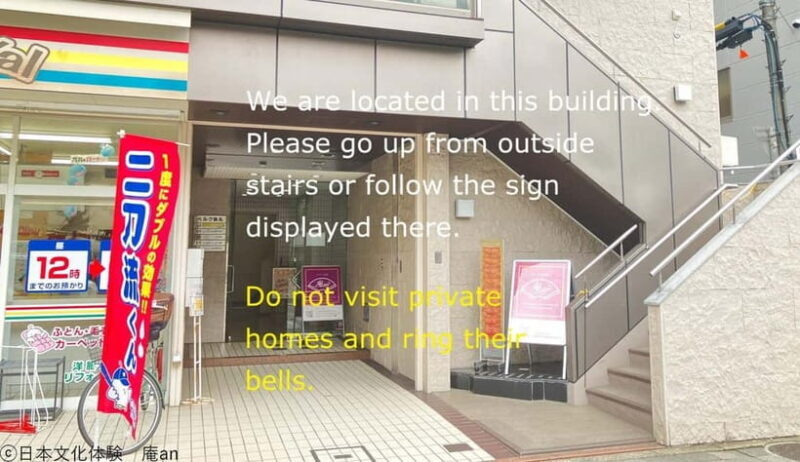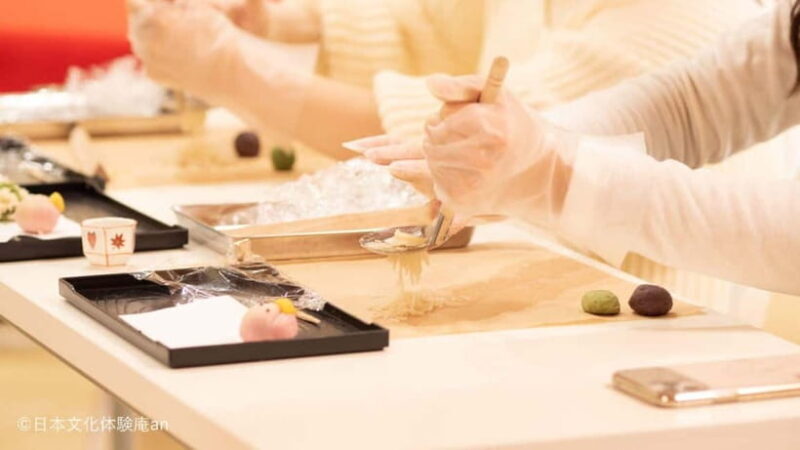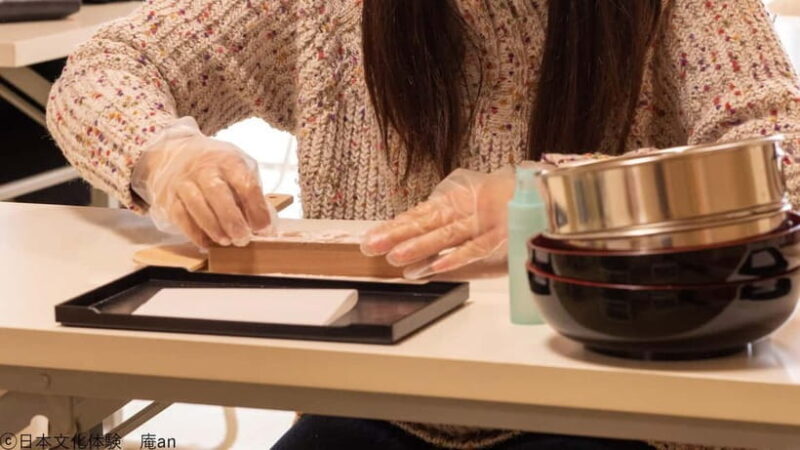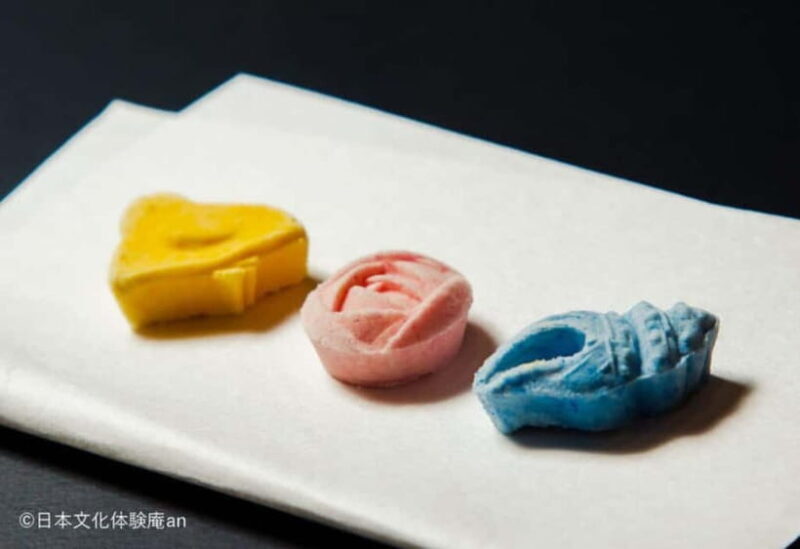Authentic Japanese Sweets and Tea Ceremony Experience in Kyoto

If you’re looking to go beyond the usual tourist spots and truly experience a slice of Kyoto’s rich culinary culture, this tour offers a warm, engaging introduction. For just $29, you get to visit a cozy venue near Gojo Station, where you’ll spend roughly 1 hour and 55 minutes making traditional Japanese sweets—Ohigashi and Nerikiri—and participate in a relaxed matcha tea ceremony.
What we love about this experience is how it combines hands-on confectionery making with a casual, accessible interpretation of tea culture. The use of Kyoto-made white and red bean pastes and single-origin matcha adds authenticity that makes the process both meaningful and memorable. Plus, the well-paced schedule offers ample time for learning, tasting, and photo opportunities.
A small caveat is that the venue involves stairs, and there’s no elevator, so travelers with mobility issues should plan accordingly. Also, the schedule is tight, so punctuality is important to ensure you enjoy every part without feeling rushed. This tour is perfect for those curious about Japanese sweets or looking for a warm, interactive cultural experience in Kyoto—especially if you want a taste of local craftsmanship rather than just sightseeing.
You can check availability for your dates here:Key Points

Authentic Experience: You’ll make two seasonal Nerikiri sweets and Ohigashi using traditional Japanese ingredients.
High-Quality Materials: The sweets incorporate Kyoto’s long-established bean paste shops and single-origin matcha.
Learning and Tasting: The process is explained clearly, with opportunities to taste your creations and enjoy a casual tea ceremony.
Convenient Location: Located just a minute walk from Gojo Station, easy to reach with public transport.
Value for Money: For $29, you get three distinct experiences—an excellent price considering the hands-on involvement and cultural insights.
Limited Accessibility: No elevator, so stairs are involved; plan accordingly.
While in Kyoto, here are other experiences we've covered
A Closer Look at the Experience

Location and Meeting Point
The experience begins just a minute walk from Exit 1 of Kyoto’s Gojo Station on the Karasuma subway line. The venue’s entrance faces Gojo-dori, making it easy to find if you keep your eyes peeled. The convenience of a central location means you can easily combine this with other sightseeing in Kyoto.
The Itinerary Breakdown
The day is structured into three main parts, each rich with learning and participation:
1. Japanese Dried-Type Sweets (Ohigashi)
Starting with a brief introduction, you’ll learn about Wasanbon, a traditional Japanese sugar. Then, you’ll make Ohigashi, a dried sweet that’s often enjoyed during tea ceremonies or festivals. The process involves working with special Japanese sugar, which is less sticky and more refined than regular sugar, giving the sweets a distinct texture and flavor. This part lasts about 20 minutes, and you’ll understand the craftsmanship involved in traditional Japanese confectionery.
2. Making Seasonal Nerikiri Sweets
Next comes the more visually striking flower-shaped Nerikiri, made from white or red bean paste. These colorful, delicate sweets are shaped to match the season—think cherry blossoms in spring or chrysanthemums in autumn. The instructor will guide you through Kinton Nerikiri, a classic style of sweet often used in tea ceremonies. Expect about 30 minutes of hands-on work, where you’ll learn how to mold and decorate with natural colors (additional 200 JPY if you want to add colors). This part highlights Kyoto’s seasonal aesthetic and craftsmanship.
3. The Tea Ceremony and Matcha Preparation
The final segment involves making your own Matcha—from grinding the powder to whisking it into a frothy bowl. This process is accompanied by an explanation of the significance of tea in Japanese culture. The tea ceremony is kept informal and accessible, designed to allow participants to experience the essence of Japanese hospitality without the formality. You’ll also get to take photos and enjoy your carefully prepared Matcha.
More Great Tours NearbyAdditional Details
The entire experience is designed to be informative and friendly, with explanations provided in English as much as possible. The schedule ensures you have time to taste your sweets, enjoy the tea, and take photos—a real plus for those wanting to bring home memories.
- 2-Hour Shopping Tour Plan / private
- 6-Day Private Tour to Kyoto via Fukui from Fukuoka with Bus
- 2 Types of Japanese Sweets making and Tea Ceremony
- Kyoto: Insider Sake Brewery Tour with Sake and Food Pairing
- 4.5-hr Kyoto Historical Highlights Bike Tour with UNESCO
- 4-Day Scenic Japan Tour by Car: Tokyo Mt. Fuji Kyoto & Osaka
Authenticity and Quality
One of the highlights is the use of high-quality ingredients. The sweets are made with long-established Kyoto bean paste, guaranteeing a genuine flavor, and the single-origin matcha offers a more nuanced taste compared to mass-produced powders. This focus on quality elevates the experience from a typical workshop to a meaningful cultural activity.
Group Size and Atmosphere
While the exact group size isn’t specified, reviews imply a small group setting. This personal approach makes it easier to ask questions and get individualized tips. The venue’s cozy atmosphere enhances the feeling of being welcomed into a local artisan’s space, rather than a generic workshop.
What Do Travelers Say?

With a 4.5-star rating from 14 reviews, this tour consistently receives praise for its authenticity and value. One reviewer mentioned, “We loved the way we could make seasonal sweets and learn about Japanese sugar,” highlighting the hands-on nature. Another appreciated the casual tea ceremony—”It was simple, relaxed, and very authentic,” they said—perfect for those new to Japanese traditions.
Some feedback points out that stairs could be a challenge for some, so travelers with mobility issues should prepare accordingly. Others note that the schedule is well-paced but might feel a little rushed if you arrive late, emphasizing the importance of punctuality.
Why This Tour Works Well

This experience is ideal for culture enthusiasts, food lovers, or anyone interested in Japanese craftsmanship. It’s especially suited for travelers who prefer interactive activities over passive observation. If you’re traveling with children (under 2 sitting on laps are free), they can enjoy the experience too, making it a family-friendly option.
While it’s not a comprehensive tour of Kyoto, it provides a unique insight into traditional Japanese sweets and tea culture. For those wanting a meaningful, hands-on activity that’s not overly long or expensive, this experience offers great value.
The Sum Up

This Japanese sweets making and tea ceremony experience in Kyoto balances authenticity, interactivity, and affordability beautifully. For only $29, you get a chance to learn about Kyoto’s confectionery traditions, make beautiful seasonal sweets, and enjoy a casual matcha tea ceremony, all in a friendly, accessible setting.
It’s perfect for travelers who want an engaging cultural activity that they can feel proud of and remember—especially if they’re curious about Japan’s culinary artistry. The high-quality ingredients and personalized guidance combine to create a memorable, worthwhile experience.
Whether you’re a first-time visitor or a seasoned Japanophile, this tour offers a delightful way to deepen your appreciation for Kyoto’s culinary heritage—a sweet spot in your journey through Japan.
FAQ
Is this experience suitable for children?
Yes. Children sitting on their parents’ laps are free of charge if under 2 years old. The experience is generally family-friendly, especially since it’s interactive and gentle.
How long does the experience last?
The total duration is approximately 1 hour and 55 minutes, including breaks, making it a manageable activity for most travelers.
Where is the meeting point?
It’s just a minute walk from Exit 1 of Kyoto’s Gojo Station on the Karasuma Line. The venue faces Gojo-dori, so it’s very easy to find.
What is included in the price?
You’ll participate in three experiences: making two types of sweets and a casual tea ceremony. The fee covers all materials and guidance.
Can I add colors to my sweets?
Yes, for an additional 200 JPY, you can add natural colors to your Nerikiri sweets, enhancing their visual appeal.
Is there an option to take my sweets home?
Yes, for 100 JPY, you can purchase a sweets take-out box to bring your creations back.
Are there any language limitations?
The experience is primarily conducted in Japanese, but translation support is provided as much as possible, making it accessible for English speakers.
What if I want to reschedule or cancel?
You can cancel up to 24 hours in advance for a full refund. Changes after that may incur fees, and last-minute cancellations are subject to the provider’s policy.
Is this experience available year-round?
Yes. The operation hours are from 10:00 to 17:00, and reservations can be made within this window. Be aware that no experience is held after 17:00, and schedules are subject to availability.
Taking part in this hands-on sweets and tea experience offers a wonderful window into Kyoto’s culinary traditions, all in a warm, friendly environment. It’s a perfect addition to any Kyoto itinerary for those craving cultural authenticity and a chance to make delicious memories.
You can check availability for your dates here:More Dessert Tours in Kyoto
- Japanese Sweets Making with Seasonal Motifs
- Kyoto Sweets and Green Tea Making and Town Walk.
- Traditional Tea Ceremony with Matcha and Sweets in Kyoto
- Kyoto Wagashi(Japanese sweets) Cooking Class near Fushimiinari
- Kyoto: Traditional Tea Ceremony with Matcha and Sweets
- Japanese Sweets Making with a Skilled Artisan
More Tour Reviews in Kyoto
More Kyoto experiences we've covered
- Kyoto Guided Day Tour with Free Admission
- Cultural Theater Experience in Gion Kyoto
- Kyoto Higashiyama Gion Sunset Cycling Tour
- Shimogamo Shrine and Nishiki Market Bus Tour from Kyoto
- From Nagoya: Kyoto Day Tour with Pork Shabu Shabu Lunch
- Kyoto Mystery Route Adventure Journey Off the Beaten Path
- Kyoto: Walk Through History in Shimogamos Sacred Woods
- Kyoto Timeless Rickshaw Private Tour
- 2-day Kansai world ExTour I tour around Osaka,Kyoto,Nara,andUji
- Private Custumized Walking Tour with a Local Guide
- Kyoto and Nara Day Tour With English Guide
- Hiroshima and Miyajima 2 Day Private Tour from Kyoto or Osaka
